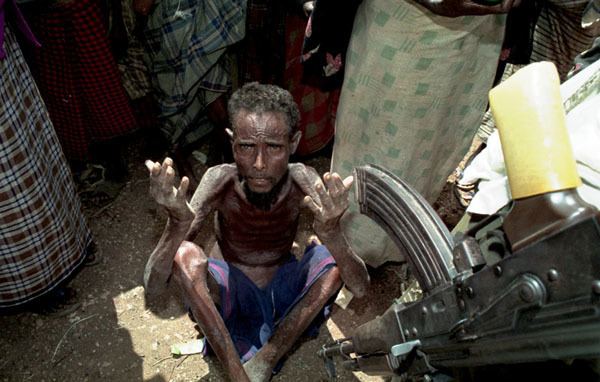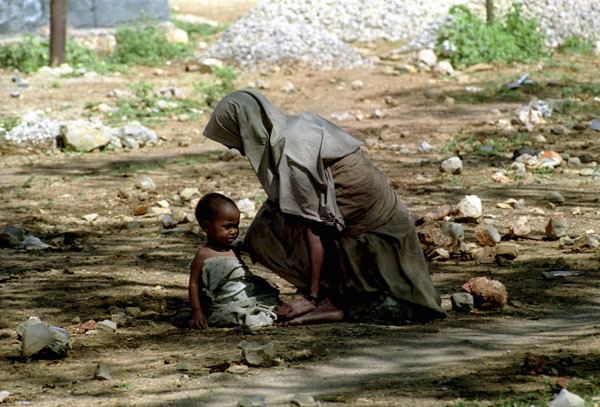Country Somalia District Baidoa | Region Population 157,500 | |
 | ||
Map of Baidoa
Baidoa (Somali: Baydhabo), is capital in the southwestern Bay region of Somalia. During the Middle Ages, Baidoa and its surrounding area was part of the Ajuran Sultanate. in 2005 Transitional Federal Government established temporary headquarters in Baidoa before an eventual relocation of government offices to Mogadishu.
Contents
- Map of Baidoa
- Exclusive evidence of war crimes in somalia kismaayo marka baidoa jilib
- Darul uluum taha baidoa somalia
- Early history
- Civil war
- Southwestern State
- Demographics
- Climate
- Education
- Transportation
- Subdivisions
- Notable residents
- References

In 2012, it was made the capital of the Southwestern State of Somalia, a prospective Federal Member State.
Exclusive evidence of war crimes in somalia kismaayo marka baidoa jilib
Darul uluum taha baidoa somalia
Early history
Baidoa and the broader Bay region is home to a number of important ancient sites. Archaeologists have found pre-historic rock art on the city's outskirts, in Buur Heybe.
During the Middle Ages, Baidoa and its surrounding area was part of the influential polity that covered much of southern Somalia and eastern Ethiopia, with its domain extending from Mareeg in the north, to Qelafo in the west, to Kismayo in the south.
In the early modern period, the Baidoa area was ruled by the Geledi Sultanate. The kingdom was eventually incorporated into Italian Somaliland in 1908, and ended in 1910 with the death of its last Sultan Osman Ahmed. After independence in 1960, the city was made the center of the official Baidoa District.
Civil war
Baidoa later incurred significant damage in the early 1990s, following the start of the civil war. In September 1995, United Somali Congress militia attacked and occupied the town. They remained in control of Baidoa until around January 1996, while the local Rahanweyn Resistance Army militia continued to engage the USC in the town's environs. In 1999, the RRA seized control of the wider Bay and Bakool provinces. The town and larger region gradually rebounded to become among the more stable areas in the south.
In 2002, the RRA's leader Hasan Muhammad Nur Shatigadud founded the Southwestern State of Somalia regional administration, with its headquarters in Baidoa. The creation of the autonomous state was a move to show the RRA leadership's disaffection with the nascent Mogadishu-based Transitional National Government, which had been established two years earlier. In 2005, the Southwestern State was officially dissolved after its leader Shatigadud had joined the Transitional Federal Parliament in November 2004 and later became Minister of Finance in January 2005 in the Transitional Federal Government (TFG), the TNG's successor.
In early 2005, the TFG sent official delegations to Baidoa and Jowhar to assess the suitability of each city as a temporary headquarters for the TFG before an eventual relocation of government offices to Mogadishu. In June–July 2005, the Transitional Federal Government established an interim seat in Jowhar due to ongoing insecurity in the capital. To strengthen its presence in the town, the central authorities built an improved airport and inaugurated the Duduble Canal. The TFG later moved its temporary headquarters to Baidoa.
In December 2006, Ethiopian troops entered Somalia to assist the TFG against the advancing Islamic Courts Union, initially winning the Battle of Baidoa. On 28 December 2006, the allied forces recaptured the capital from the ICU. The offensive helped the TFG solidify its rule. On 8 January 2007, for the first time since taking office, President Abdullahi Yusuf Ahmed entered Mogadishu from Baidoa to engage in consultations with local business, religious and civil society representatives as the TFG moved its base to the national capital.
Following their defeat, the Islamic Courts Union splintered into several different factions. Some of the more radical elements, including Al-Shabaab, regrouped to continue their insurgency against the TFG and oppose the Ethiopian military's presence in Somalia. Throughout 2007 and 2008, Al-Shabaab scored military victories, seizing control of key towns and ports in both central and southern Somalia. At the end of 2008, the group had captured Baidoa but not Mogadishu. In February 2012, Somali government forces and allied Ethiopian troops re-captured Baidoa from Al-Shabaab.
Southwestern State
In December 2013, a convention began in Baidoa between Federal Government officials and local representatives with the aim of establishing an autonomous state in the area under the Provision Federal Constitution. Two simultaneous political processes for the establishment of a new Southwestern State of Somalia were underway: one led by former Parliament Speaker Sharif Hassan Sheikh Adan, which proposed a three region state consisting of the Bay, Bakool and Lower Shabelle provinces; another led by convention organizer Malaq Ali Shino, former MP Madobe Nunow Mohamed and erstwhile Bay region Governor Abdifatah Geesey, which proposed instead the re-establishment of a six region Southwestern Somalia state consisting of the Bay, Bakool, Lower Shabelle, Gedo, Middle Jubba and Lower Jubba provinces.
Demographics
According to the UNDP in 2005 the population of Baidoa was 227,761. The city is situated at the center of one of the most densely populated areas in the nation. It is an ethnically and culturally diverse town, with many local residents originating from other parts of the country.
Additionally, Baidoa is the heartland of Maay, an Afro-Asiatic language principally spoken by the Digil and Mirifle (Rahanweyn or Sab) clans in the southern regions of Somalia. Its speech area extends from the southwestern border with Ethiopia to a region close to the coastal strip between Mogadishu and Kismayo. Maay is not mutually comprehensible with Standard Somali, and it differs considerably in sentence structure and phonology. However, Maay speakers often use Standard Somali as a lingua franca, which is learned via mass communications, internal migration and urbanization.
Climate
Baidoa has a hot and semi-arid climate (Köppen BSh), as with much of southern Somalia. By contrast, towns in the northern part of the country generally have a hot arid climate (Köppen BWh).
Education
Baidoa has a large secondary school, from which around 100 pupils graduated per year in 2008. As of 2012, several other high schools were in development.
Tertiary education in the city is served by the University of Southern Somalia. After a considerable planning stage, the institution was established in 2007 by a group of Somali scholars and intellectuals. Inaugural classes began the following year, in August 2008. University representatives concurrently announced plans to develop four colleges: the College of Science, Agriculture, and Engineering, the College of Social Science, the College of Education, the College of Health and Environmental Sciences, and the College of Jurisprudence. Additionally, an Institute of Social Research is being developed. Plans are also in the works to construct a new campus in an area around 15 km north of Baidoa, as well as two new branches in two other principal cities in the Bay region.
Transportation
Air transportation in Baidoa is served by the Baidoa Airport. Sitting at an elevation of 1,520 feet (463 m), it has a 9843 × 131 ft (3000 × 40 m) asphalt runway. The airport has fuel services, a terminal building, storage container, on-site warehouse, and radio towers.
Subdivisions
Baidoa is administratively divided into four districts:
Notable residents
Sharif Hassan sheikh adan. Current president of south west somalia
